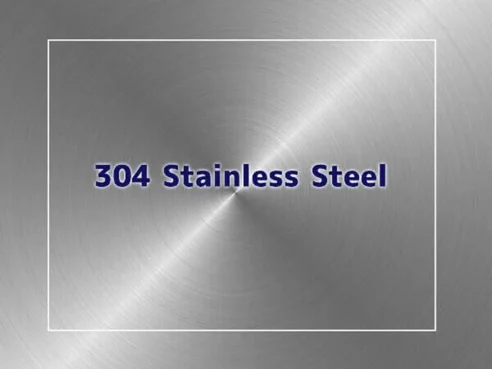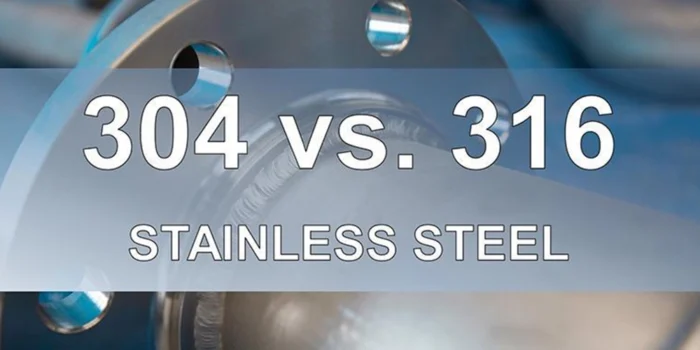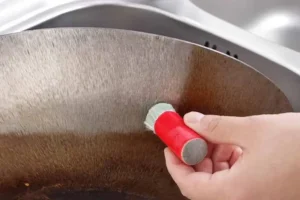304 stainless steel is a widely used material, especially in industry and construction, known for its excellent resistance to corrosion and high temperatures, making it ideal for many applications.
What is 304 Stainless Steel
304 Stainless Steel[1] is an 18/8 austenitic stainless steel[2], which is the most common and most commonly used alloy in the stainless steel family, with a composition of 66-75% iron, 18-20% chromium, and 8-10.5% nickel and other trace elements, and is favored for its ability to withstand harsh environments and maintain its structural integrity over long periods, thus ensuring long life and reliability in applications such as kitchen equipment and industrial machinery.
304 stainless steel is a general-purpose stainless steel material with stronger rust resistance than 200 series. 304 stainless steel has excellent corrosion resistance and good intergranular corrosion resistance.For oxidizing acids, the experiment showed that: in nitric acid below the boiling temperature of s65% concentration, 304 stainless steel has strong anti-corrosion. It also has good anti-corrosion ability for alkaline solutions and most organic and inorganic acids.It is also relatively good in high-temperature resistance, can reach 1000-1200 degrees.
As stainless heat-resistant steel, 304 stainless steel is widely used in food equipment, general chemical equipment, and atomic energy industry equipment. It can also be used to make equipment and parts that require good comprehensive performance (corrosion resistance and formability).
304 Stainless Steel Variants
- 304 Stainless Steel
304 stainless steel is a standard austenitic stainless steel, belongs to the “18-8” stainless steel family, containing about 18% chromium and 8% nickel. It is the most widely used grade of stainless steel and is known for its good corrosion resistance, formability and weldability.
- 304L Stainless Steel
304L[3] is a low carbon variant of 304 stainless steel (the “L” stands for “Low Carbon”), with the carbon content reduced to ≤0.03%. The low carbon design reduces carbide precipitation (sensitization) during the welding process, thereby improving resistance to intergranular corrosion.
- 304H Stainless Steel
304H[4] is a high carbon variant (H for “High Carbon”) with a carbon content ranging from 0.04-0.10%.The higher carbon content increases high-temperature strength, making it suitable for high-temperature and high-pressure environments.
| Material | 304 | 304L | 304H |
| Carbon Content | ≤0.08% | ≤0.03% | 0.04-0.10% |
| Advantage | Versatility, corrosion resistance, cost-effectiveness | Intergranular corrosion resistance, excellent weldability | High temperature strength, oxidation resistance |
| Suitable Environment | Mild to moderate corrosion (e.g.,indoor, food processing) | Welded structures, moderate corrosion (e.g., chemical, food) | High temperature environments (e.g. boilers, petrochemicals) |
| Limitations | Not suitable for high chloride or strong acid environments | Same as 304, but with better weldability | Not suitable for low temperature or highly corrosive environments |
| Application | Construction, kitchen equipment, medical equipment | Storage tanks, pipelines, brewing equipment | Heat exchangers, refinery equipment, industrial furnaces |
304 Stainless Steel Chemical Composition
| Element | Composition (%) |
| Chromium (Cr) | 18.0 – 20.0 |
| Nickel (Ni) | 8.0 – 10.5 |
| Carbon (C) | ≤ 0.08 |
| Manganese (Mn) | ≤ 2.00 |
| Silicon (Si) | ≤ 1.00 |
| Phosphorus (P) | ≤ 0.045 |
| Sulfur (S) | ≤ 0.030 |
| Iron (Fe) | Balance |
304 stainless steel typically contains 18-20% chromium and 8-12% nickel, which are key elements contributing to its corrosion resistance and formability.
Chromium forms a stable oxide layer on the surface that protects the metal from oxidation and rusting, making it ideal for environments exposed to moisture and corrosive substances
Nickel is added to enhance the ductility and toughness of the steel,and improves resistance to acids and oxidation.
Mechanical Properties of 304 Stainless Steel
| Property | Value |
| Tensile Strength | ≥ 515 MPa |
| Yield Strength (0.2%) | ≥ 205 MPa |
| Elongation | ≥ 40% |
| Hardness (HRB) | ≤ 95 |
| Density | 8.0 g/cm³ |
304 Stainless Steel Physical Properties
| Property | Value |
| Melting Point | 1450 °C |
| Modulus of Elasticity | 193 GPa |
| Electrical Resistivity | 0.72 x 10-6 Ω.m |
| Thermal Conductivity | 16.2 W/m.K |
| Thermal Expansion | 17.2 x 10-6/K |
304 Stainless Steel Features
Stainless steel 304 is favored for its unique properties, making it ideal for a variety of industrial applications.
Excellent Corrosion Resistance
Grade 304 has exceptional resistance to corrosion. It performs well in a variety of environments, including marine and industrial settings, due to its ability to withstand mild acids and alkaline substances.
Chromium creates a passive layer against corrosion,protects it from rust and wear,extending longer service life even in challenging conditions,also has good durability.
Strength and Durability
304 stainless steel is also known for its strength and durability. Its structural composition allows it to withstand high loads, making it ideal for heavy-duty applications where reliability is critical, ensuring that products made from 304 stainless steel maintain their integrity and performance over time.
Temperature Resistance
304 steel performs well at elevated temperatures, maintaining its mechanical properties and structural integrity under thermal stress.However, it is important to note that stress corrosion cracking can occur above 60°C, particularly in chloride environments.
Great Weldability and Formability
304 stainless steel still has good mechanical properties in -180 ℃ under the condition. It has good plasticity, toughness, and cold working properties in the solid solution state. Grade 304 can be easily processed through cutting, shaping, welding, and bending, making it versatile for various manufacturing processes.
Its ductility allows it to be formed into intricate shapes without compromising its strength, easy to fabricate into everything from tubing to kitchen sinks.
Applications of 304 Stainless Steel
304 stainless steel is a versatile material widely used in various industries due to its excellent properties, especially corrosion resistance, ease of fabrication and aesthetics.
- Kitchen Appliances and Cookware
pots and pans, knives, sinks, etc. Kitchenware made of 304 stainless steel is durable, hygienic and safe, is the first choice for family kitchens.
- Medical Equipment
surgical instruments, dental equipment, etc. The corrosion resistance and biocompatibility of 304 stainless steel make it an ideal material in the medical field.
- Building Decoration
curtain walls, railings, handrails, etc. 304 steel is strong and durable, and also enhances the aesthetics of buildings, ensuring a long service life.
- Chemical Equipment
reactors, pipelines, storage tanks, etc. The corrosion resistance of 304 stainless steel makes it indispensable in the chemical industry.
- Transportation
automobile exhaust systems, train carriages, aircraft parts, etc. The lightweight and high strength characteristics of 304 make it widely used in transportation.
Disadvantages and Limitations
Despite its superior performance, 304 is still deficient in certain environments.
- Not ideal in chloride-heavy environments (like coastal or marine settings),its corrosion resistance is significantly reduced, which may lead to pitting and crevice corrosion.— 316 stainless steel is better there.
- Can corrode in strong acids or salt exposure over time.
- Work hardens quickly — may require annealing during fabrication.
Comparison with Other Stainless Steels
304 Vs 316 Stainless Steel[5]

304 and 316 stainless steel are two common austenitic stainless steels known for their excellent corrosion resistance and differ significantly in their chemical composition.316 stainless steel contains 2% molybdenum, which significantly enhances its corrosion resistance, especially in chlorinated environments, making it suitable for marine applications.
With the addition of molybdenum and higher nickel in 316 stainless steel, 316 is more expensive than 304.304 is suitable for general environments and economical needs, while 316 is more suitable for harsh environments and high-strength requirements in application scenarios.
304 Vs 304L
The “L” in 304L stands for “low carbon”. It has ≤ 0.03% carbon compared to ≤ 0.08% in 304. That small difference improves weldability and resistance to intergranular corrosion, especially in thicker sections.
Use 304L for welded components or where stress corrosion is a concern.
Sustainability
304 stainless steel is recognized not only for its performance characteristics but also for its sustainability properties. One of its main advantages is durability; the long life of the material minimizes the need for frequent replacements, thus reducing long-term costs.
In addition, 304 stainless steel is fully recyclable, durable, safe and environmentally friendly, making it the material of choice for the food industry.
Disclaimer: Many things here represent our opinion. We can therefore never claim to be correct or complete. And never base a business decision solely on the news you receive from us.
[1]: Explore this link to understand the unique properties and applications of 304 Stainless Steel, a versatile material in various industries.
[2]: Learn about the significance of 18/8 in stainless steel, which indicates its composition and benefits in durability and corrosion resistance.
[3]: Exploring this link will provide you with detailed insights into the benefits and uses of 304L stainless steel, enhancing your understanding of its applications.
[4]: Learning about 304H can provide insights into its applications in industries, enhancing your material selection knowledge.
[5]: Explore the unique properties of 316 Stainless Steel that make it ideal for marine and chemical environments.





